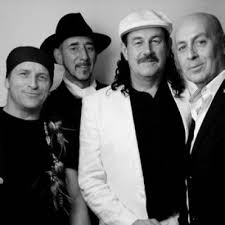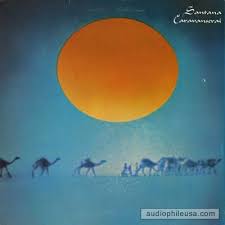Caravanserai
| SantanaCaravanserai
Caravanserai is the fourth studio album by the American rock band Santana, released on October 11, 1972. Caravanserai marked a major turning point in Carlos Santana's career as it was a sharp departure from his critically acclaimed first three albums.-Wikipedia
Critic Reviews
Show All-
 George Starostin's Reviews
George Starostin's Reviews
This strikes me as tons more interesting than any of Santana's two earlier records (not to mention later ones) and even more engaging than Santana III - I'd go as far, indeed, as to call this Santana's masterpiece, and the most wonderful and convincing emotional tour-de-force you'll ever get out of this band.
-
 Robert Christgau
Robert Christgau
Still, I'm happy to report that the experiment--away from Latino schlock and toward Mahavishnu you can dance to, sort of--is not only honest but successful and not only successful but appropriate.
-
 Ultimate Santana
Ultimate Santana
But on this album, they're playing a style of music that just doesn't fit their talents -- and it shows. There's no doubt that Caravanserai is a critical step in Santana's musical journey, but in and of itself, it is not one of his best albums.
-
 JazzTimes
JazzTimes
October 1, 2003. The album mixes rock, jazz and salsa with tracks such as “Eternal Caravan of Reincarnation,” “Stone Flower” and “La Fuente del Ritmo,” but you can tell that Santana is itching to stretch out and stay there for a while.
-
 The Great Albums
The Great Albums
Fans of the band’s more pop-minded sides may want to steer clear of this album, but if you like jazz-fusion or enjoy hearing Santana in full jam mode, you’ll almost certainly adore this disc.
-
 Wilson & Alroy's Record Reviews
Wilson & Alroy's Record Reviews
So some of the record is shapeless, but the cumulative effect is relaxing, and even moving in the meditative way that Carlos clearly intended. Definitely not a record for beginners, but an interesting effort. (JA) 3/5 Pleasant but too low key, except for the supremely funky "Look Up (To See What's Coming Down)." (DBW)
-
 AllMusic
AllMusic
Like the type of jazz that influenced it, this pearl . . . requires a number of listenings in order to be absorbed and fully appreciated. But make no mistake: this is one of Santana's finest accomplishments.
-
 Rolling Stone
Rolling Stone
December 8, 1976. Caravanserai, while it is different from all of Santana’s previous work, still has enough of the Santana original sound to provide familiarity. Carlos himself has as individual a sound on guitar as Miles does on trumpet and you hear him singing away on his strings on and off throughout the LP.
-
 The Music Aficionado
The Music Aficionado
October 10, 2018. More changes were to come soon, and these sessions document a band in transition while in search of a new purpose. The result is one of the best albums of that period, a spiritual blend of jazz, rock and Latin music like no other. This is the story of Caravanserai, my favorite album in the band’s catalog.
-
 Jazz Music Archives
Jazz Music Archives
February 1, 2011.
-
 The Absolute Sound
The Absolute Sound
November 9, 2012. Musically the chemistry among band members remained, however, as did the Latin fire, the rhythm section still scorching as the band pursued a more jazz-oriented approach. Capturing Caravanserai’s expansive yet detailed sound was no easy task, and in some respects— the way Tom Rutley’s acoustic bass cuts through, for example—the result was impressive.
-
 Sea of Tranquility
Sea of Tranquility
November 18, 2003. Santana's fourth album, Caravanserai, finally being reissued and remastered by Columbia Legacy/Sony, is a landmark recording for the band. Originally released in 1973, this album marked a change for the band, as they were moving away from the Latin tinged psychedelic pop rock of their earlier recordings to a more ethereal, jazz fusion based sound.
-
 Classic Rock Review
Classic Rock Review
March 12, 2013. Altogether `Caravanserai’ showcases contributions by some 16 different musicians and is a masterpiece of arrangement and production; it marks the beginning of a rich and productive journey into deeper, more complex jazz-fusion territory which continued with `Welcome’ and – especially – `Borboletta.’
-
 Classic Rock Review
Classic Rock Review
April 2, 2013. Guitarist Carlos Santana and his band sound like they took a good dose of Miles Davis, Mahavishnu Orchestra and the like before making this classic album, a tasty mix of jazz fusion, psychedelia and Latin rhythms and melodies.
-
 The Rocktologist
The Rocktologist
This is one of the rare few cases of an album with filler which is still a solid, unflinching masterpiece. . . . It's probably the most religious album I have ever heard - forget about "Christian rock", if you're looking to induce a spiritual catharsis, Caravanserai is the album with which to do it . . . .
-
 The Music Box
The Music Box
January, 2004. . . . Carlos Santana’s oft-forgotten fourth studio recording Caravanserai is an equally strong outing that finds the guitarist stepping out in a new direction. Steeped in jazz- fusion, the album rolls along at a comfortable pace, so much so that this, perhaps, explains why it’s been so difficult for many to fully grasp.
-
 BetterRecords
BetterRecords
"Caravanserai is daring even by Santana's high standards. Carlos Santana was obviously very hip to jazz fusion -- something the innovative guitarist provides a generous dose of on the largely instrumental Caravanserai ... this is one of Santana's finest accomplishments."
-
 MoFi
MoFi
The highly original Caravanserai distinguishes itself from most instrumentally based albums in that its purpose isn't to tout virtuosic jamming abilities but to take the listener places they've never been, and do so in a manner that's cohesive, focused, and inventive. Santana delves deeply into jazz's boundless possibilities without exploiting technique or structure, arriving at sonic intersections where jazz is the main landing spot for soul, Latin, and funk tangents.
-
 Sit Down Listen Up
Sit Down Listen Up
April 4, 2015. Caravanserai belongs in the bright constellation of progressive rock albums that transcend categories. Like Mahavishnu Orchestra’s Birds of Fire, it will not be eclipsed, no matter how the years cascade.
-
 fusion 101 radio
fusion 101 radio
February 5, 2018. There’s not a low point to be found and the highs are numerous and unforgettable. They created a work of art that is accessible and understandable to even the most casual progressive mind while weaving a tapestry of tones and rhythms that is indescribable. It simply must be heard to believe.
-
 Elsewhere
Elsewhere
. . . it has stood the test of time, perhaps because it appeals to the more mellow stoner and has a measure of relaxed maturity about it rather the frenetic pace of some earlier outings, thrilling though they were.
-
 hifi.nl
hifi.nl
December 13, 2011. Carlos Santana, too, was a pioneer in the merging of musical movements and released one of his most beautiful albums of all time in 1972.
-
 Darwin Monkey
Darwin Monkey
The distict song structures of Abraxas and Santana III are gone, and a largely instrumental conceptual fluidity replaces it in homage to the new listening sphere of Shrieve and Santana; Miles Davis, Mahavishnu Orchestra, Charles Lloyd and Gabor Szabo. Nonetheless, this is primarily a trademark Santana album.
-
 nokey-a-media-jets
nokey-a-media-jets
Caravanserai is the latest release from Rock Superstar Santana, and I can only think of one word to describe it… AWESOME!



Rate This Album and Leave Your Comments